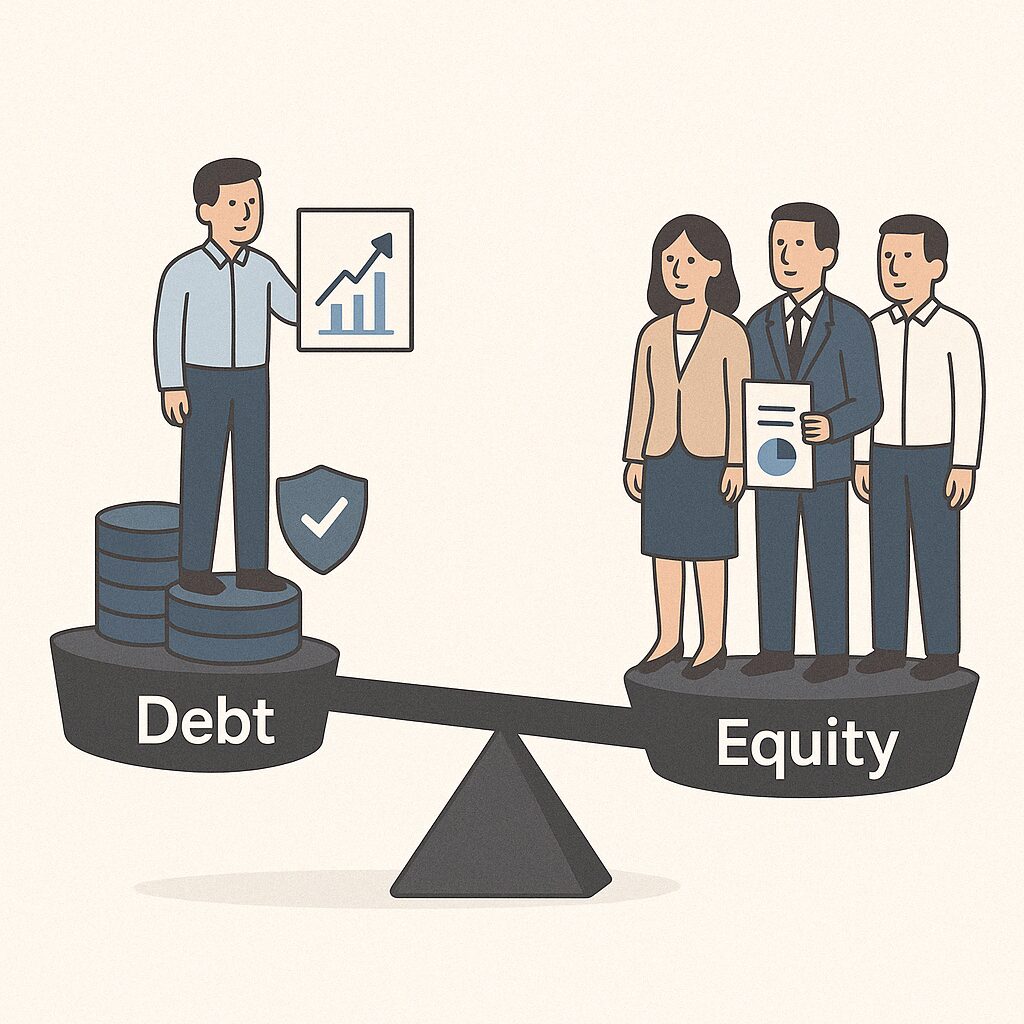Non-Dilutive Venture Debt: When and What for?
Part 3 of a 4-Article Series: Exploring the Cost of Capital
If you haven't yet read Part 2: Cost of Capital: The Real Cost of Equity, click here
Nicolas Gallo
April 28, 2025
Introduction: The Role of Debt in Startup Financing
Debt has long been a fundamental tool for established businesses, but for startups, it often takes a backseat to equity. This is due to several factors, including a lack of available funding alternatives, the overwhelming focus of the industry on equity financing, and a common misunderstanding of debt pricing. Many founders shy away from debt due to perceived risks or unfamiliarity, but it is crucial to recognize that debt can provide significant advantages, particularly when used strategically to fuel growth and leverage capital.
In this article, the third in our Cost of Capital series, we will explore the key characteristics of debt financing, its real cost, and when it is the most appropriate option for startups. By understanding both the benefits and risks, founders can make informed decisions about using debt as a strategic tool for growth, without falling into common traps.
Typical Aspects of Debt Financing
No Dilution – Keep Your Equity
Debt financing allows startups to raise capital without giving up ownership. Unlike equity financing, which requires founders and early investors to part with shares, debt enables companies to access the funds they need while preserving their existing cap table. This makes it a highly attractive option for founders who want to maintain their equity position—especially those planning a future equity round. By using debt to extend runway and hit key growth milestones, they can raise equity later at a higher valuation and significantly reduce dilution.
Retain Control
Beyond preserving equity, debt financing empowers founders to retain full decision-making authority. With no new shareholders at the table, there's no pressure to compromise on strategic direction, company culture, or long-term vision. This is especially important for founders who have already raised equity and are wary of losing further control as their investor base expands. Debt lets you grow on your terms, without handing over the reins.
Leverage
Debt provides startups the opportunity to leverage their existing capital, allowing them to accelerate growth without giving up equity. With the right strategy, borrowed capital can be put to work funding revenue-generating activities, such as expanding sales teams, increasing marketing efforts, or investing in product development.
The concept of leverage is well understood in traditional businesses, but many tech founders, particularly those without a financial background, may hesitate due to perceived risks. However, properly managed leverage can be a powerful tool to fuel growth without surrendering ownership. The key is having a clear plan for using the debt effectively and a strong understanding of the company’s ability to service that debt.
As a company grows, debt should progressively become a more important tool in its financial management. This approach is well-understood by big enterprises, which on average maintain a debt-to-equity ratio of 1:1. In contrast, startups and scaleups often overlook debt as a viable financing option and tend to rely heavily on alternatives like equity, which, after a certain stage, become more expensive than debt (as explained in our article on The Real Cost of Equity).
Tax Shield
A valuable advantage of debt financing is the tax shield. Interest payments on debt are tax-deductible, effectively lowering the company's taxable income and, as a result, reducing the overall cost of borrowing. This is particularly useful for profitable companies generating taxable income.
Even companies that are not currently profitable can potentially benefit from this mechanism. In Switzerland, for example, tax losses can generally be carried forward for seven years and offset against future taxable profits.
Cost of Debt Calculation
Unlike equity, which can be difficult to value for early-stage startups, the cost of debt is relatively straightforward to calculate. The core cost of debt is simply the interest rate on the borrowed funds. However, a more complete view of the cost of debt must also consider the tax shield and any associated fees (e.g., arrangement fees, service fees, or prepayment penalties).
The basic formula for calculating the cost of debt is:

This formula accounts for the tax savings generated by the interest deductions, providing a clearer picture of the true cost of borrowing. While interest payments might seem like the primary cost, it’s important to include all associated expenses in your analysis.
Debt vs. Equity
The decision between debt and equity financing is one of the most critical choices for startup founders. Both options offer distinct advantages and come with their own sets of risks. Here, we will explore the scenarios when equity financing is the preferred choice and when debt financing might be the better alternative for startups.
When Makes Good Sense to Use Equity
Equity financing is often the preferred option when a company is in the early stages or lacks the predictable cash flow needed to secure debt. In such cases, equity provides the necessary capital without the obligation to repay a fixed amount over time. It’s especially useful when a company is still developing its product, acquiring customers, or refining its business model.
Beyond capital, equity financing brings several other valuable benefits:
- External Validation: Securing funding from investors can act as validation for the startup, signaling to potential customers and partners that the business has a solid foundation.
- Signaling for Hiring: Raising equity can also signal to top talent that the company has the resources and backing to grow, making it easier to attract and retain skilled employees.
- Expertise and Network: Investors often bring more than just capital, they provide industry expertise and access to valuable networks, which can be crucial for navigating growth challenges.
However, the trade-off with equity is dilution. Every time a company raises equity, the shareholders ownership stake is reduced. The more equity is raised, the more the shareholders share of future profits and control diminishes. Additionally, once a company enters the cycle of continuous fundraising, it becomes increasingly difficult to undo the effects of dilution, which can lead to tensions between founders and investors as goals and expectations diverge.
When Debt Makes Sense
As the company matures and predictable revenue streams emerge, debt financing becomes a viable and often preferred option. For startups that have stable recurring revenue models and high gross margins (such as SaaS businesses), debt financing provides the opportunity to scale quickly without losing control.
Debt financing is particularly advantageous in several scenarios:
- Accelerating Growth: For businesses with proven go-to-market strategies (GTM), debt can be used to fund expansion, invest in sales teams, or increase marketing spend, all while avoiding dilution.
- Bridge Financing: Debt is also useful for extending runway between equity rounds, especially in times of market uncertainty or when founders prefer not to raise equity at unfavorable valuations.
- M&A Opportunities: Debt can also be used to finance mergers and acquisitions (M&A), allowing companies to grow through strategic acquisitions without giving up more equity.

What Lenders Expect vs. Equity Investors
Lenders are more conservative than equity investors. They expect the company to have predictable revenues and the ability to meet its repayment obligations. Lenders typically require collateral to mitigate the risk of default. They are not as concerned with the company’s potential for rapid growth but are focused on the ability to service the debt.
In contrast, equity investors are looking for high growth potential and market disruption. They are willing to accept higher risk in exchange for potentially high returns. Equity investors expect to see significant scaling and market share capture, understanding that not all investments will pay off but banking on the few that will generate substantial returns.
The fundamental difference between the two is risk appetite: debt is about managing predictable risk, while equity is about embracing the potential for higher returns at higher risk.
Risks Associated with Debt
Despite its many advantages, debt financing carries significant risks, particularly for startups with unpredictable cash flow or those in uncertain stages of development.
Cash Flow Strain and Debt Servicing
Startups with volatile or unpredictable cash flow face the greatest risk when using debt. Unlike equity financing, where repayment obligations are flexible, debt requires regular, fixed payments that must be met regardless of the business’s financial health. If cash flow is inconsistent, servicing this debt can lead to liquidity issues that could jeopardize business operations.
Bankruptcy Risk: The Ultimate Consequence of Mismanaged Debt
One of the most significant risks associated with debt financing is the potential for bankruptcy. When a company is unable to meet its debt obligations, it can default, triggering legal consequences and damaging its financial reputation. In extreme cases, companies may face bankruptcy, where they either restructure their debt or liquidate assets. Bankruptcy can lead to the loss of valuable assets, control of the business, and the potential closure of operations.
For founders, bankruptcy can mean not just the loss of the company but a long-term reputational risk, making it more difficult to secure future financing or raise capital for new ventures.
Conclusion
Debt financing can be a highly effective tool for scaling Tech startups with stable cash flow, predictable revenue, and a clear plan for repayment. It allows companies to avoid giving up equity and maintain control while benefiting from the tax shield of interest payments. It also provides a great alternative to companies with sound business models that are not suitable for additional Equity rounds for many reasons, like broken cap tables and growth levels that are not enough for VC investors.
However, this tool must be used wisely, which means: allocate it to the right use, at the right time.
Build smarter. Scale faster. Give up less.
Join 400+ founders getting our monthly insights on capital and growth.
Learn more about Industry Insights

Cost of Capital: A Guide for Startup Founders
Tag: Funding Strategies

Cost of Capital: The Real Cost of Equity
Tag: Funding Strategies

